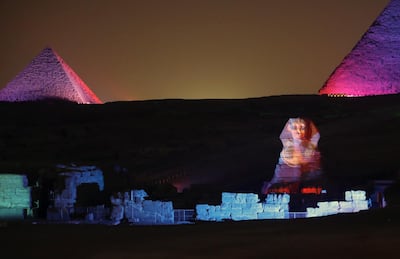Built on the orders of the pharaohs thousands of years ago, the Great Pyramid of Giza continues to reveal its secrets.
On Thursday, scientists shared the discovery of a corridor inside the 4,500-year-old structure at an unveiling ceremony held at the Giza Plateau.
The previously hidden corridor is the latest discovery of the ScanPyramids project, a mission made up of heritage experts from Cairo University and the French Heritage Innovation Preservation Institute.
As Egypt’s most-visited attraction and the last remaining intact wonder of the ancient world, the great pyramids are shrouded in mystery with little consensus on how the giant structures were built.
The discovery of the concealed tunnel could lead to more findings on the construction of the pyramids, according to science journal Nature.
For curious travellers planning a trip to Egypt's pyramids, here's everything you need to know.
How do you get to Egypt's Great Pyramids?

The Great Pyramid of Giza — also known as the Pyramid of Cheops or Khufu — sits beside the pyramid of Khafre and the pyramid of Menkaure, which make up the Giza Plateau.
The pyramids are located on the western outskirts of Cairo, and the easiest way to reach the destination is by car — whether that's via taxi, Uber or a private driver.
Public transport is available via the metro, with the nearest station to the pyramids on Al Haram Road. From here, it’s a short taxi ride or local bus trip to the site.
Once on-site, tourists can walk around the ancient structures or hop on one of the first batch of e-buses designed to take visitors through seven stations around the plateau.
There are also hotel options in the vicinity of the Giza Plateau, where travellers spending the night can simply walk across the desert to the pyramids.
What’s inside the Great Pyramid of Giza?
Despite the discovery of the hidden corridor inside the Great Pyramid of Giza, travellers need to lower their expectations a little before visiting the historic tomb, as most parts of the inner sanctums of the historic structure remain off-limits to tourists.
What visitors can see is the King's Chamber, Queen's Chamber and Grand Gallery. The King's Chamber is where Khufu was believed to have been buried. The only item in the room is the monarch's sarcophagus, hollowed out of a block of granite. Despite there not being too much to look at, it's fascinating to see the towering pyramid's strong structure from within.
No photography is allowed inside the tomb and tourists should be aware that it gets rather hot as there is no air conditioning inside.. Venturing into the tomb is not recommended for anyone who has claustrophobia.
Can I climb to the top of the pyramids in Giza?
Travellers cannot climb to the tops of the pyramids.
While visitors used to be able to roam freely around the structures, authorities introduced a ban on the activity back in the 1950s, although it wasn't always enforced then. That's not the case today.
In 2016, teenage tourist Andrej Ciesielski received a lifetime ban from Egypt after posting photos and videos of his pyramid climb on social media.
In 2019, a law banning climbing on Egypt's antiquities was introduced, carrying with it penalties of at least one month in prison and fines of more than $6,000. Despite this, tourists often try to stand on the lower rows of the pyramid stones for photographs.
How much does it cost to visit the pyramids?
Prices to visit the Great Pyramid of Giza are a reasonable 240 Egyptian pounds ($7.8) for tourists, with students able to enter at half that price. It's worth noting that this rate doesn’t include access to the tombs — a separate entrance fee applies to enter inside any of the pyramids.
Tickets to the Great Pyramid cost Dh52.50, while Khafre and Menkaure tickets are Dh12 each.
When is the best time of year to visit the pyramids?

Open daily from 7am to 4pm, the pyramids are best seen from October to April, when the weather is not too warm. The site is open to tourists year-round, but travellers visiting in summer will want to avoid the mid-day heat.
What else can travellers see there?

After visiting the three pyramids and the nearby Great Sphinx of Giza, travellers who want to explore further can scout out the plethora of tombs, temple ruins and smaller-sized pyramid structures dotted around the desert plateau.
The 9 Pyramids Lounge is the only on-site restaurant and has built a name for itself as the place to dine if you want lunch served alongside Instagram-friendly vistas of Egypt's ancient treasures.
After the daytime viewing closes, the Giza Plateau comes alive with a night-time light show that illuminates the historic structures. Telling the tale of ancient pharaonic legends, it projects images on to rock faces and uses the pyramids as an awesome backdrop. Tickets cost about $20, but the show is also visible from several rooftops surrounding the site.
For great photo opportunities or an alternative light-show viewing without a steep price tag, try the nearby KFC and Pizza Hut, where a rooftop terrace offers picture-perfect vistas of the ancient wonders — accessible for the price of a piece of fried chicken.
The inside tip

Avoid riding the camels and donkeys that wander around the Giza Plateau. Not only are you likely to be asked to pay a hefty fare, but you will also be spending your tourism dollars for supporting activities using wildlife where the welfare of the animals cannot be verified.










